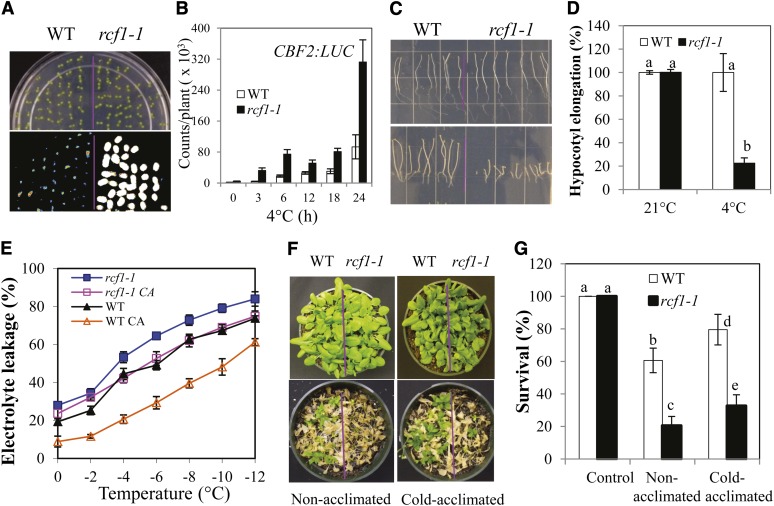Figure 1.
RCF1 Is a Positive Regulator of Cold Tolerance.
(A) CBF2:LUC expression in 7-d-old wild-type (WT) and rcf1-1 seedlings treated at 4°C for 24 h.
(B) Quantification of luminescence intensity in (A). CBF2:LUC expression was quantitatively measured as luminescence intensity (counts/plant). Data are also included for nonstressed and cold-treated seedlings at different time points.
(C) Chilling sensitivity of the wild type and rcf1-1 at 4°C in darkness. Top panel, 21°C for 15 d; bottom panel, 4°C for 52 d.
(D) Quantification of hypocotyl elongation of plants shown in (C). Hypocotyl elongation of the wild type at 21°C or 4°C was treated as 100%.
(E) Leakage of electrolytes from excised leaflets of rcf1-1 and wild-type plants when treated at temperatures below freezing. rcf1-1 CA, cold-acclimated rcf1-1 plants; WT CA, cold-acclimated wild-type plants.
(F) Whole-plant freezing tolerance of the wild type and rcf1-1. Plants were photographed 10 d after freezing treatments.
(G) Survival rates of rcf1-1 and the wild type in (F).
Error bars represent the sd (n = 20 to 40 in [B], 60 to 100 in [D], 8 to 16 in [E], and 100 to 140 in [G]). One-way analysis of variance (ANOVA; Tukey-Kramer test) was performed for data in (D) and (G), and statistically significant differences are indicated by different lowercase letters (P < 0.003). Experiments in were repeated at least three times with similar results, and values shown are from one experimental repetition.

